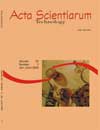Lead as a heavy metal from urban wastes of Maringá PR
DOI:
https://doi.org/10.4025/actascitechnol.v23i0.2756Keywords:
esgoto, biossólido, metais pesados, nutrientes, poluição ambiental, matéria orgânicaAbstract
Human wastes are a permanent environmental challenge. Present research analyzed the amount of lead in the sewerage and sludge of the Sewerage Treatment Stations (STSs) of Maringá PR. Samples collection were undertaken at STSs. Sewerage samples were digested with nitric acid and reduction volume. Biosolid samples previously dried at constant weight were ground and digested by aqua regia. Metal concentrations were determined by atomic absorption spectrometry. The pH, nitrogen, carbon and organic matter (OM) were determined by the respective classical methods. Total average values were: a) Pb in affluent sewerage 0.089 and effluent sewerage 0.070 µg.mL-1. b) biosolid: Pb = 388.8 µg.g-1; pH = 3.38; N = 3.24 %; C = 24.5 % e OM = 42.1 %. Based on variance analysis of experimental values taking into account the variation sources of the stations (STSs) and collecting time, it has been reported that, at level of 1 % confidence, there were no significantly difference between the values of lead concentration, N (%), C (%) and organic matter (%) respectively in the two variation sources. Amounts of organic matter and C:N (carbon:nitrogen) ratio of sewage sludge are appropriated for soil applicationDownloads
Download data is not yet available.
Downloads
Published
2008-05-05
How to Cite
Lenzi, E., Galli, D., Ricardo de Melo, S. A., & da Silva, E. V. (2008). Lead as a heavy metal from urban wastes of Maringá PR. Acta Scientiarum. Technology, 23, 1325–1334. https://doi.org/10.4025/actascitechnol.v23i0.2756
Issue
Section
Chemistry
License
DECLARATION OF ORIGINALITY AND COPYRIGHTS
I Declare that current article is original and has not been submitted for publication, in part or in whole, to any other national or international journal.
The copyrights belong exclusively to the authors. Published content is licensed under Creative Commons Attribution 4.0 (CC BY 4.0) guidelines, which allows sharing (copy and distribution of the material in any medium or format) and adaptation (remix, transform, and build upon the material) for any purpose, even commercially, under the terms of attribution.
Read this link for further information on how to use CC BY 4.0 properly.
0.8
2019CiteScore
36th percentile
Powered by 



0.8
2019CiteScore
36th percentile
Powered by 

















8.png)




